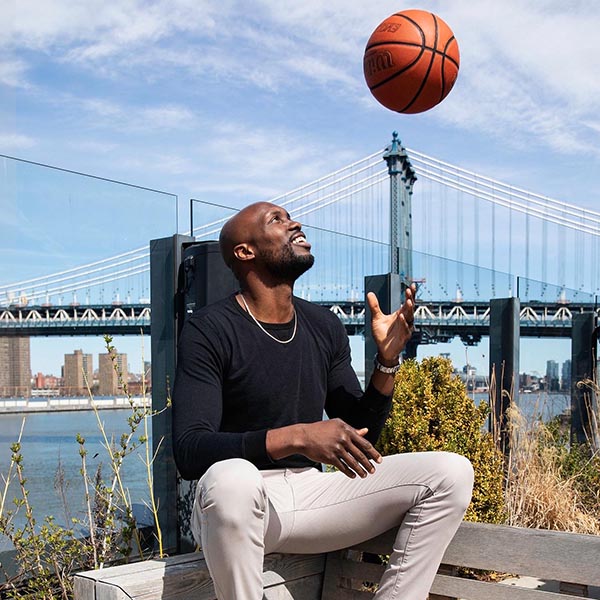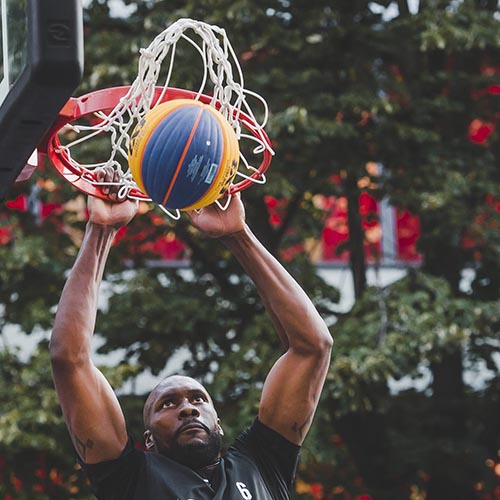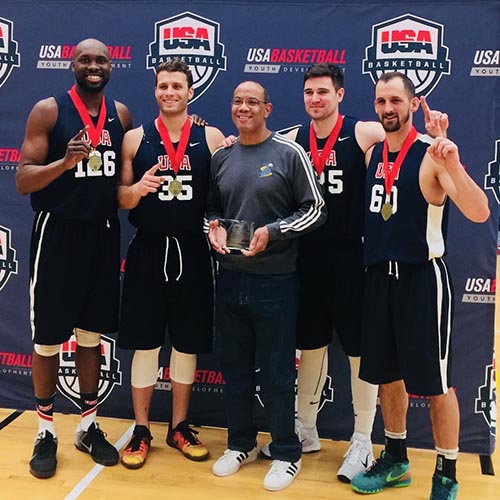Zahir Carrington ’10 ’12G is sitting in a posh Manhattan physical therapy office, having just finished treatment on his knee. It follows surgery to repair a torn meniscus. The surgeon also injected stem cells into the joint to promote cartilage regeneration. Carrington played all last season of professional 3x3 basketball despite the injury.
 At 35 years of age, there is too much at risk as players entering the league are younger and younger. Carrington was an alternate on Team USA’s 3x3 Olympic Qualifying Team for the sport’s premiere at the 2020 Olympics, only to have that moment lost to COVID-19.
At 35 years of age, there is too much at risk as players entering the league are younger and younger. Carrington was an alternate on Team USA’s 3x3 Olympic Qualifying Team for the sport’s premiere at the 2020 Olympics, only to have that moment lost to COVID-19.
He’s ahead of schedule with his recovery and feeling good enough that he hit the court recently for the first time in months.
“I was playing the best basketball of my life in February 2020,” he says. “So I am going to get back out there and take this opportunity as far as I can take it.”
That mantra is what has fed him from his scrappy youth in Philadelphia to his education on South Mountain to his current life in Harlem. “Grateful” is the word he uses over and over to describe the serendipity that has moved him along that journey.
He speaks about different mile markers on that road.
Earliest Basketball Memory
We were out-of-the-house kids. My brothers, cousins, and neighbors were outside after school and all summer long. We’d go play basketball in the yard or on the playground. I always played, but that doesn’t mean I was any good. In middle school, I often got picked to play at recess because I brought the basketball to the court. But there were times when I wasn’t picked, and that lit a fire in me. I wasn’t a coordinated kid, so I had to work hard. I played football and ran track. By 8th grade, I was six feet tall. That’s when I began to take basketball more seriously. Then over the next 18 months, I shot up another six inches.
Basketball in High School
I tried out and was selected for the Positive Image AAU travel team sponsored by Philadelphia native and NBA great Malik Rose. We were not a powerhouse program compared to some of the other well-known teams like the Tim Thomas Playaz or Hunting Park Warriors. There were guys on other travel teams who garnered more attention and played at a higher level. Did we beat them? Yes, but our team was focused on getting better and getting to college. We used basketball as a tool to get a scholarship to college and be able to find a career afterward, whether that was on the hardwood or doing something else in the world. That team put me in a great position to succeed, and things worked out as planned.
 Coming to Lehigh
Coming to Lehigh
The transition to Lehigh wasn’t as shocking for me. I went to a good magnet high school in Philadelphia — JR Masterman Middle & High School, which had a unique cross-section of racial and socioeconomic diversity that most other Philadelphia public schools do not have. It also had a very rigorous course load with college prep and advanced placement classes. So I was prepared academically and socially.
The scholarship I received made Lehigh possible. I loved my time here. I majored in sociology and anthropology and minored in Africana studies. I enjoyed basketball and got to see playing time on the floor early in my career. I also had fun. I wasn’t playing well my senior year, and the first 10 games for our squad were tough. I then sprained my MCL and missed three games, the only missed games of my collegiate career. After I returned to the court I was determined to get us over the hump, and the team got locked in. We finished the season with the most wins in school history (at the time), and we went on to win the league championship that year. I was the MVP of the championship game versus Lafayette on my 22nd birthday! Doesn’t get sweeter than that to end my career on South Mountain!
Post-Lehigh
I had options to play basketball in European leagues after I graduated. But those options did not pay very much, so I decided to stop pursuing basketball. I was kind of done with basketball, In fact, I decided to train for a marathon and began running. But two weeks in, I thought, “This is not for me.” Basketball was great while I played, but it’s a specific skill, and I was looking for work experience and to advance my education as well. That summer after graduating, I also lost a family member to gun violence and wanted to stay close to my family in Philadelphia.
That’s when Lehigh came through for me again. I entered the master’s degree program in applied sociology and worked as a teaching assistant in the department. The Lehigh Athletics family (Joe Sterret, athletic director, and Bill Griffin, assistant athletic director) also came through for me, providing valuable work experience for the newly launched Lehigh Athletic Partnership. I worked on organizing alumni events and developing players. What I got paid was equal to what I would have earned in the European leagues, and now I was advancing my education and gaining work skills. It was a win-win. While in graduate school I also played professionally in the ABA for one and a half seasons for the Jersey City Express — a great experience that allowed me to scratch the basketball itch and stay close to the game that I love.
 Really Post-Lehigh
Really Post-Lehigh
I began to work in medical technology sales after graduate school, earning recognition and making a career for myself. But I never lost my love for the game. That’s when I met Ed Lacayo ’02, who was well-versed in the New York City basketball circles. There were a number of high-level players competing in pro-level leagues around the city. I started to play with him and others, including Donovan Mitchell, Kyrie Irving, Emeka Okafor, and Joakim Noah. Then Craig Moore introduced me to 3x3 basketball and asked me to travel with the team to a competition in the USA Basketball 3x3 National Championship Tournament. While I didn’t travel then, I finally acquiesced to Craig and began to play.
Found 3x3
The game is so different from 5x5. There is a 12-second shot clock. It’s played on a half court. Twenty-one points wins the game. It is continuous play, no stopping, almost a 10-minute sprint. Unlike 5x5 basketball, 3x3 players are positionless. No one is specialized. You have to do it all well — move, handle the ball, guard, pass, shoot, and rebound. When you only have two teammates, mistakes are amplified. A bad 30 seconds might cost you a tournament.
I played 3x3 basketball for the first time at the USA Basketball National Championship tournament in 2017. We lost the first game and went on to win the rest, taking home the national title. From there we traveled and competed in the World Cup. That same year, the International Olympic Commission added 3x3 to its medal program. We knew we had what it took to make it there and win. After this announcement came out, my focus shifted to playing more 3x3 on the FIBA professional World Tour circuit and trying to land a spot on the team for the 2020 Tokyo Olympics.
 Olympic Bound
Olympic Bound
2020 was a big year. I got married, and our team was fighting to qualify for the Olympic games. The Olympic qualifying trials were held in February 2020 in Chicago. It was there that I was selected as a qualifying team alternate. Four players are selected and two alternates, essentially the top six 3x3 players in the nation. Then COVID-19 canceled everything. No Olympics. No indoor gyms. With years of wear and tear on my body and just getting older, my window of time is smaller. It’s just a snowball effect.
Coming out of the pandemic, there were fewer events. The IOC held the games in 2021, but I was an alternate. It wasn’t about wins or losses or my style of play. It was just one of those ways that decisions get made. Sadly, the decision didn’t fall in my favor. You can’t control what you can’t control. I am still in the pool and still feel like I can make it. But we are facing a world of players who have stepped up their games in response to the United States dominance in 5x5 basketball.
Owner Operator
I am a co-owner of the 3x3 teams that I play on (Princeton and Chicago). So in addition to playing on the court, I am also making roster decisions, coordinating travel, and running operations alongside my teammates Craig Moore and Damon Huffman, the other co-owners. While 3x3 is in its infancy as a sport, we are putting an infrastructure in place and creating the 3x3 ecosystem from the youth level up to professional. Our goal is to create more professional playing opportunities for high-level American players after college who may not want to live overseas for nine months out of the year but still want to continue playing professionally.
 I don’t think it is an accident that Lehigh alumni end up in places of influence. I am the president of the Athletes’ Advisory Council for USA Basketball. One of my mentors, Kyle Neptune ’07, is the head coach of NCAA powerhouse Villanova. CJ McCollum ’13 is president of the NBA Players Association. Cathy Engelbert '86 '23P is the commissioner of the WNBA. Lehigh creates leaders who can combine education and athletics. The alumni network is my family. I don’t mean it lightly when I say I am grateful to them, my coaches, and teammates.
I don’t think it is an accident that Lehigh alumni end up in places of influence. I am the president of the Athletes’ Advisory Council for USA Basketball. One of my mentors, Kyle Neptune ’07, is the head coach of NCAA powerhouse Villanova. CJ McCollum ’13 is president of the NBA Players Association. Cathy Engelbert '86 '23P is the commissioner of the WNBA. Lehigh creates leaders who can combine education and athletics. The alumni network is my family. I don’t mean it lightly when I say I am grateful to them, my coaches, and teammates.